22 Small Stream Trout Fishing Tips and Tactics Used By Trout Guides
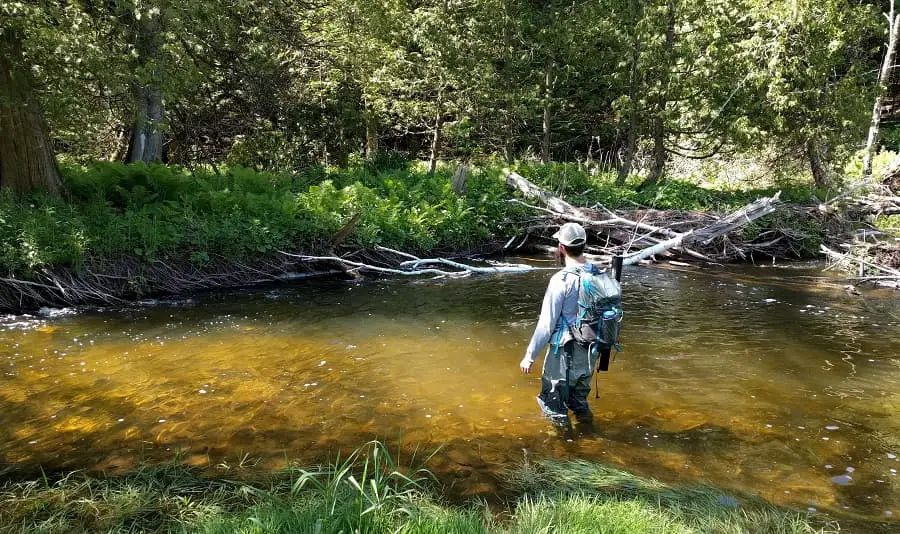
There are some things I do as a trout guide to catch more trout when trout fishing in small streams. I teach these small stream trout fishing tips and tactics to my clients so they can catch more trout consistently.
Small stream fishing for trout is easy if you use the right tactics, gear, and the right approach. In fact, when it comes to fishing small streams for trout, I think something as simple as your approach can make or break your day. I also like to use smaller baits, lighter rods and reels, and smaller leaders.
A slower, quiet approach and the right method are very important if you want to catch big trout from small streams.
1. Use The Right Methods To Catch Trout In A Stream
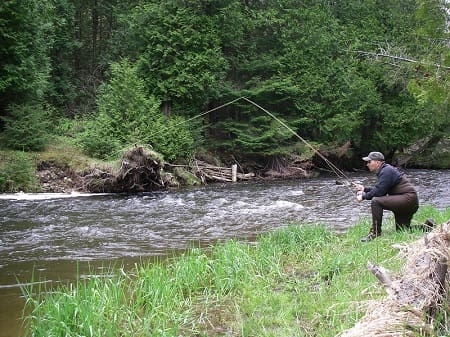
When it comes to fishing a small stream, I use different methods, which will often depend on the type of water that I am fishing.
These are some options for effective fishing methods:
- Fly Fishing: Allows you to imitate the trout’s most available food source, which is insects. This is the best method for fishing on the surface, but it’s also great for fishing below the surface.
- Spin Fishing: Spin fishing for trout is likely the most popular method. With spin fishing, you can drift baits down the stream with a float or dead drift without a float.
- Lure Fishing: Casting lures for small stream trout is a fun and effective method.
- Float Fishing & Centerpin Fishing: Float fishing with a spinning reel or a Centerpin reel is one of the most effective ways for catching trout in deeper pools but is over 3 feet deep.
- Drift Fishing Or Bottom Bouncing: These methods are great for presenting a bait without the use of a bobber.
Use The Best Method Based On Conditions
- Deeper water: If the river is slow and deep, the best method is probably to float your bait below a float, drift fish, or cast lures.
- Shallow Water: If the river is shallow and fast, then it’s better to Nymph fish with a fly rod or to bottom bounce with a spinning rod and reel.
- Surface Fishing: If the fish are rising to the surface, the best method is to drift a dry fly on the surface.
Fly Fishing Small Streams
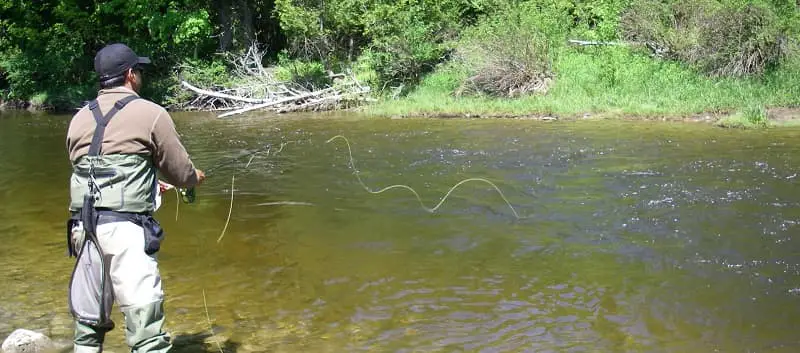
Fly Fishing is one of my preferred methods and my most productive way of catching trout in small streams and larger streams.
Brook trout, brown trout, and rainbow trout in small streams will eat a lot of aquatic insects, and in many cases, aquatic insects can be their primary food source. With fly fishing, you can easily imitate these bugs and catch feeding trout that are eating insects on the surface or below the surface.
With fly fishing, you can drift nymph flies below the surface, or you can do dry fly fishing, which means you are floating your flies on the surface.
Flies are not only for small trout, I and my clients catch and release many large trout on tiny flies.
You can also use streamer flies which are flies that imitate larger bait like fish, leeches, crayfish, frogs, and even mice.
Learn To Fly Fish – 10 Easy Steps From A Pro River Guide.
Spin Fishing Small Streams
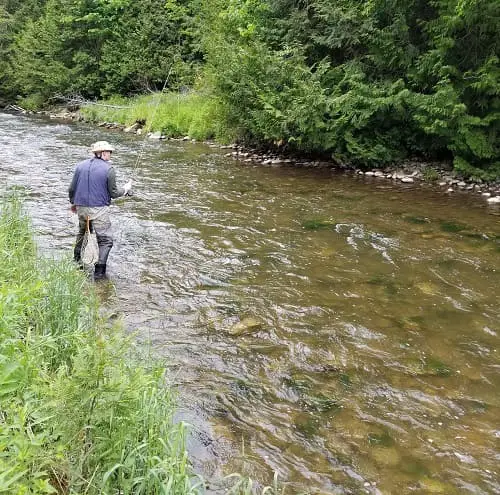
Spin fishing is a great small-stream trout method and is good for bait fishing or for using artificial lures.
Trout will hold and feed in shallow water as you see in the image, and the best method to fish this type of water is fly fishing or bottom bouncing.
Using my advanced bottom bouncing setup and method of bait fishing will help you catch more trout in water under three feet deep, especially if it’s very clear water.
Most lures just do not work well and float fishing with a boober is best in water deeper than 3 feet.
You can also fish flies below a float or with the bottom bouncing method. See Flies With Spinning Gear.
Also, check out Spin Fishing For Trout: Guide Methods and Tips for More Trout
Centerpin Fishing Streams
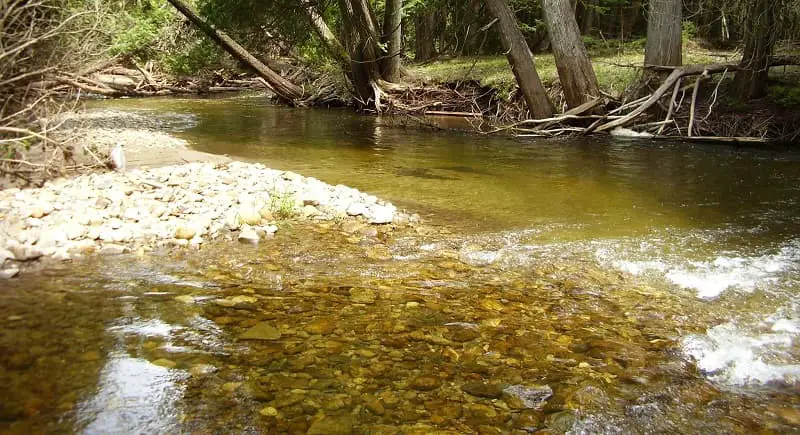
Centerpin fishing is a good when small stream fishing for trout if the water is deeper. Small stream fishing for trou
Centerpin fishing is basically float fishing, except that you are using a special reel called a Centerpin reel, also known as a float reel.
2. Use The Right Fishing Gear
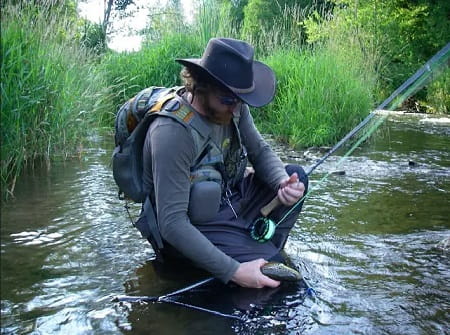
The right gear includes everything from the rods and reels, waders, vests, and down to the little things like the proper hooks, leader, floats, etc.
Guide Tip: Wear waders to keep you dry and comfortable and to protect your legs from poisonous plants, biting insects, and sharp objects.
Use a vest or a pack to carry all your gear and leave the tackle box at home.
Always have a net to make sure you land that big trout, and it’s much better for the fish if you practice catch-and-release fishing.
For all the gear that you need to river fish, check out my page River Fishing Gear: Everything You Need To Succeed
3. Rods, Reels, And Lines For Small Stream Fishing
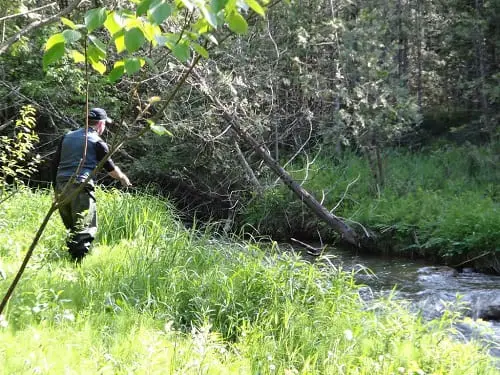
Ultra-Light and Short Spinning Rods – For very small streams with lots of overhead trees or lots of bush where casting is difficult, use small 5 to 6-foot ultralight rods like the five-foot ultralight St.Croix Premier trout rod with a very light line of 2 to 6-pound test lines on small size 10 or 15 reels like theAbu Garcia Revo X.
You can get spinning rods and fly rods in this length.
On rivers where there is not as much overhead bush, I would suggest going with a long rod. For casting lures, I use a seven-foot ultra-light St. Croix Premier rod on a size 15 reel with a 2 to 6-pound line.
If I’m going to do both lure fishing and float fishing, I will use an 8-foot or an 8’6″ rod like my favorite 8’6″ St. Croix Premier rod with a 15 to 20-size spinning reel with 6-pound line.
If you mostly want to use bait under a float or drift baits without a float using the bottom bouncing method, I would recommend a long rod like a nine or 10-foot ultralight rod. I prefer a nine to eleven-foot ultralight rod like the Daiwa Presso Ultralight Spinning Rod. I will match this to a size 20 reel with a 6-pound line.
These longer rods will give you better line control and better drifts, and the longer rods act as a shock absorber to protect lighter leaders.
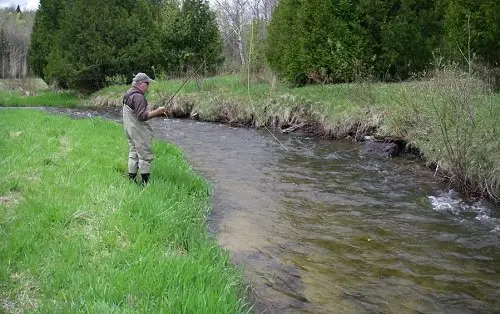
Fly fishing rods to catch trout in streams: In fly fishing, the trend is longer and longer rods.
If you want to mix it up and dry fly fish, streamer fish, and nymph fish, I would recommend a three to five-weight fly rod that is nine feet long.
If you want to specialize in nymph fishing for trout on streams, then go with a two or three-weight ten-foot fly rod. If you want to only fish dry flies, especially on smaller rivers, consider an eight or nine-foot fly rod that is two to four-weight.
4. Go With Thinner Leaders For More Trout
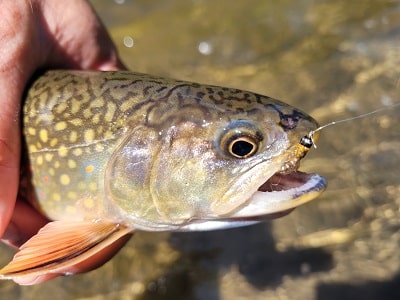
The water in small streams is usually very clear, and trout can be line-shy and will see thicker leader lines.
If they see the line, they will not bite the bait or fly. This mostly matters with slow-moving baits but not lures.
I will sometimes go as light as a two-pound test line. A lighter line will allow my bait to sink faster, it also allows my bait to move at a more natural speed and the fish will not see the leader.
With shorter rods, I will go up 1 or 2 sizes but this is what I use for leaders when trout fishing. Longer rods protect your leader better.
- 6lb pound – Lure Fishing – See Lure Fishing For Trout
- 3 to 5 pound – Bottom bouncing or float fishing 3lb, 4lb, or 5 pound
- 3lb or 4 pound – Fly fishing with nymphs or dry flies
Learn more about the right leader on my page What Pound Test Leader For Trout.
5. Use Fluorocarbon Leaders
Fluorocarbon leaders tend to sink better, and they are the most invisible to the fish so it’s the best leader for baits that are underwater.
For bait and flies below the surface, I always use a fluorocarbon leader, but for dry fly fishing, I will use monofilament leaders.
For lure fishing, any leader will be fine because the lure is moving so fast that the fish rarely see the line.
6. Use The Right Size Hooks
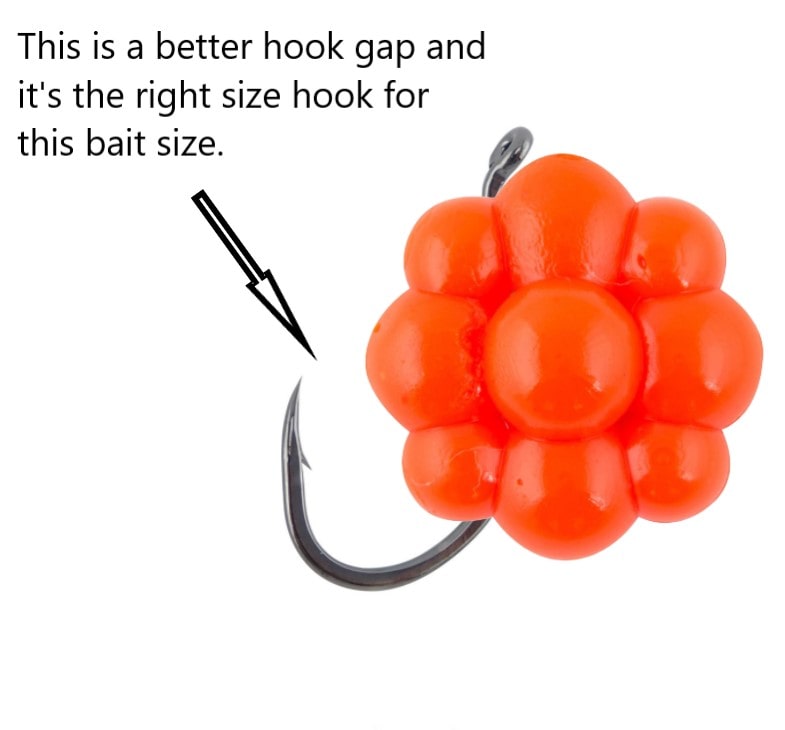
You could have everything just right and even have a bait that the trout love, but if you have the wrong hook on the line, it could cause you to not get any bites, or it could cause you to lose your trout.
Guides tend to use the best hooks simply because they work better. Check out my page Best Hook Size For Trout: A Guides Advice On Trout Hook Size.
7. Know How To Properly Set Up Your Leader
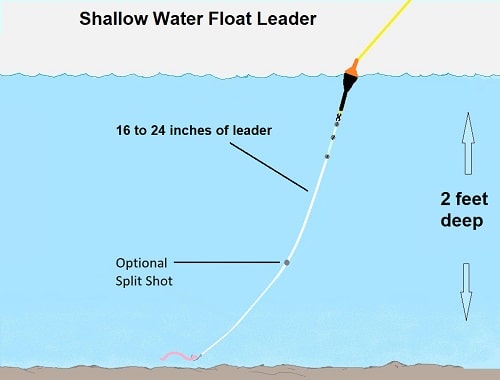
Whether you fly fish, bottom bounce, or float fish, you will need to set up your leader properly.
A poorly constructed leader will lead to problems and fewer trout in the net.
I even use a fluorocarbon leader for lure fishing, which I discuss on my page Lure Fishing For Trout.
If you want to catch trout in a small stream, you will need to know how to set up your leader, and you can find out more about that on my page 2 Float Fishing Leader Setups From A Pro River Guide, or my page on bottom bouncing which has the leaders for that very productive method.
8. Polarized Glasses Are Very Important
I use my glasses to help me read the water and find fish. My glasses help me see the deeper spots that trout might hold in as well as show me objects that trout might hide near or that I need to avoid so I don’t get snagged.
Polarized glasses even help me find safer places to cross the river.
Polarized glasses also protect your eyes from the sun’s rays and from stray hooks. My glasses have even protected my eyes from being poked by branches.
9. Know Where To Find Trout In A Stream
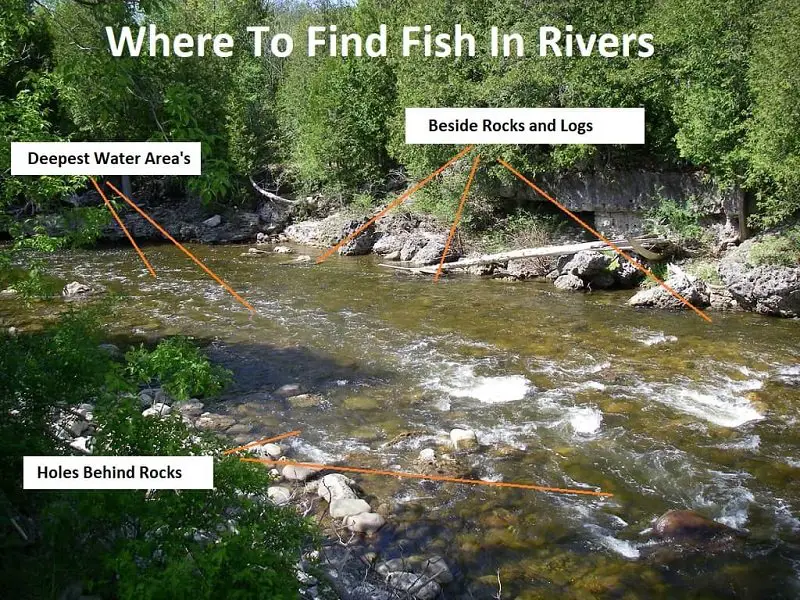
Trout will make a conscious effort to find spots in the river where they feel safe while still having access to food and without wasting energy.
Learning how to read the water and how to find these spots is a really good skill to have and it will greatly improve how many fish you will catch.
Look for depressions or deeper spots in the river, current breaks that provide some slow water, bubble lines, submerged rocks, small pockets, undercut banks, and any type of cover that fish might use.
Trout are known to migrate, so in the summer, fish farther upriver, and in the winter and spring, fish more downriver. (1)
10. Find Depth And Fish It With The Right Method
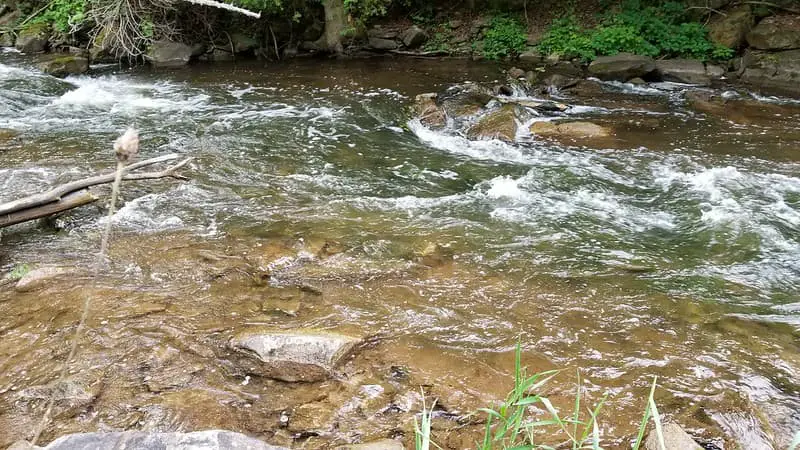
If you want to learn how to catch trout in a stream, you need to learn how to identify deeper water. Down deep, there is slow water and often cooler water where the trout feel safe.
When I talk about finding deep or deeper water where trout will hold, most anglers think about deep pools, but deeper water could simply mean a two-foot by three-foot depression in the river bed that makes the bottom go from one-foot deep everywhere to two-foot deep in that one spot. That is a spot that a trout could hold in and is always worth a try.
Deeper water could also mean a pool, ledge, or drop off, which are all good spots for trout to hold and feed in. During late summer, these are good spots to try
11. Fish The Cover: That Includes The Banks
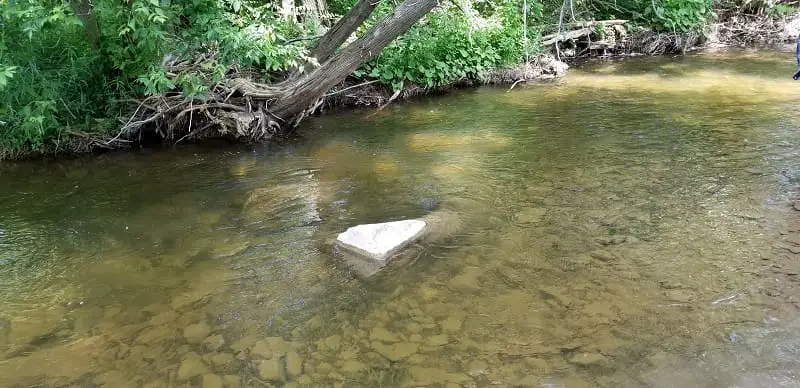
Trout in small streams like to use rocks, logs, sticks, and even deep banks as holding spots. If you want to learn how to catch trout in a stream, you need to learn to identify and fish the cover.
My clients and I have pulled 20-inch brown trout out of 20 inches of water right beside a bolder or a log.
12. Cover The Spot Thoroughly, Then Move On
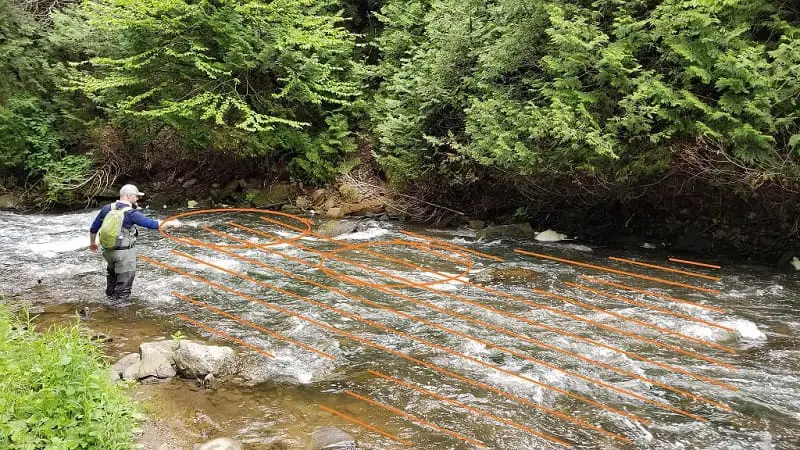
When covering the water, I look for any areas that are slightly deeper, and I look for any type of structure that fish can hold near.
Too many guys rush into a spot, make a few casts, and then rush to the next spot. They miss so many fish because of this, and they fish all over the place. They just cast aimlessly and don’t cover the spot thoroughly.
I grid or pattern every spot. I fan-cast with lures or move my lure 3 feet up or 3 feet down. with baits, I make sure I fish in lines from the top of the spot to the bottom and fish every 1 foot before I move.
Covering the water thoroughly will mean more fish. Once I think I have covered every foot, I move to the next one and do it again.
13. Be Quiet, Stay Low, And Move Slow
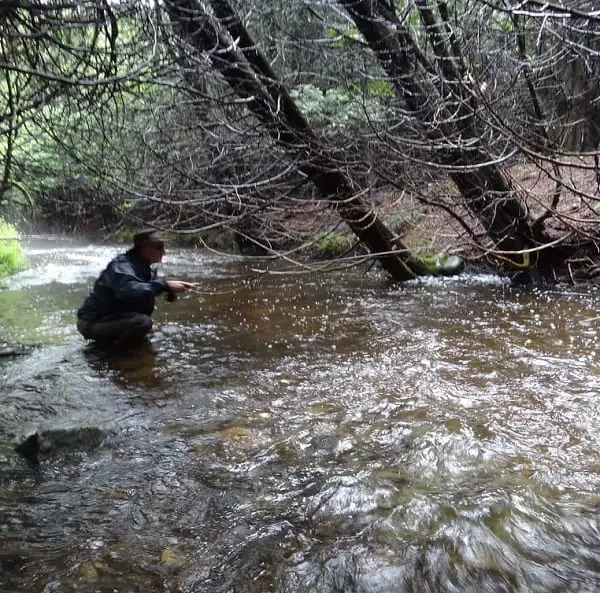
I don’t know how many times I have been silently fishing, and I hear a noise and look down the river and 200 feet away some newbie angler is splashing his way up the river and fishing every spot he sees.
These guys spook fish and catch fewer big ones.
Honestly, one of the best tips I can tell you is to avoid wading whenever possible, and move slowly, and be quiet.
I tell my clients that it’s better to tip-toe your way 6 feet into the river to get to the spot you want to fish and catch big fish right away than it is to stomp in, spook every fish, and then need to wait an hour or two for them to settle down and start feeding again.
If they hear you, your chances for big trout go way, way, way down.
Guide Tip: Being quiet also means using less split shot weight and a less conspicuous indicator or bobber that doesn’t splash down hard and spook the fish. Also, be careful your fly line doesn’t splash down hard, or that the fly line doesn’t drift over the trout in clear water, this can spook big trout.
14. Stay Behind The Fish – Or Stay Far
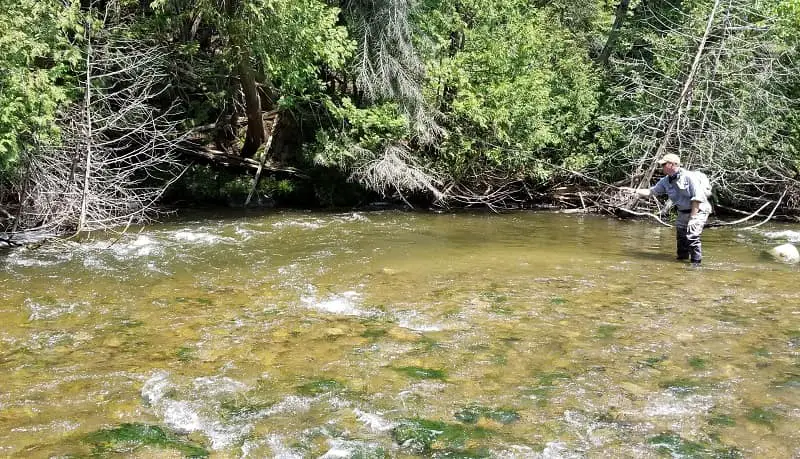
If you want to know how to catch trout in a stream remember this tip because it’s one of the most important tips I give to my clients when fishing for trout in a stream, and that tip is to stay behind the fish.
Fish look upriver, so if you fish upriver of them, they could see you, especially on a small clear trout stream. If they see you they will go lock-jaw and become nearly impossible to catch.
I think this is a big reason why many guys only catch those small dumb little trout and never catch the big ones.
Stay behind the fish and you will catch more and bigger trout.
15. Fish Closer When Possible
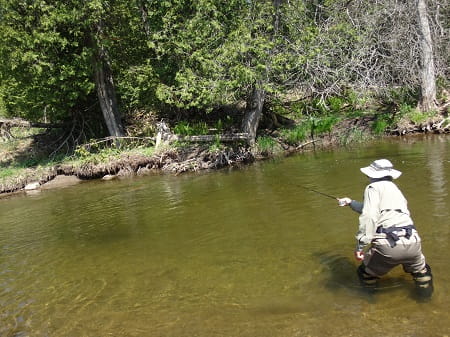
Making long casts on stream can be good because it keeps you from spooking some fish.
But making long casts on small streams requires lots of accuracy due to all the bushes, and trees, and often the spot you need to hit is small.
That is why I try to get as close as possible using a stealthy approach and staying behind the fish.
Being closer to the fish improves your chances of getting your bait in the right spot and getting a better hook-set.
16. Avoid Indicators And Big Floats
Indicators or floats can help detect subtle strikes, but big bulky and brightly colored indicators and floats splashing down on the surface over a big trout head is a great way to make them go lockjaw.
You have 2 options:
- In shallow clear water, in pocket water, or in fast water, the best method is one that doesn’t use a float, bobber, or indicator. Euro Nymphing and Bottom Bouncing are the best methods that don’t use a float or indicator.
- I use clear Drennan loafer floats in streams, and I use wool indicators like the New Zealand Indicator in the white color when fly fishing. These are subtle and less intrusive. I also recommend white indicators that look like the millions of bubbles the trout see every day.
For the best indicators check out my page What Are The Best Indicators For Fly Fishing? Guides Advice, and for the best floats for streams, check out my page Float Fishing For Trout – An Expert Guides Best Tips.
17. Change Your HookSet
Don’t overset the hook on small streams. Hooking too hard will cause lots of frustrations because your hook will be up in the trees, wrapped around your rod, or you may even hook yourself. Learn how to set fast but do it with a shorter hookset.
Practice makes perfect, and I teach my clients to do this on every other cast until it’s perfect. I discuss proper hook set in my article How To Set The Hook.
18. Work Your Way Upstream If You Can
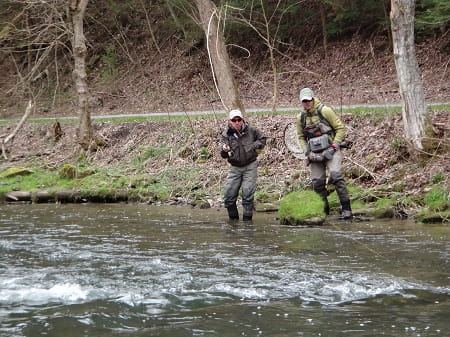
Many years ago a landowner who is an excellent river angler gave me a valuable tip that I remember and share today.
He said “Working your way down the river is basically like kicking mud and debris in the trout’s face, and the trout in my pool can sense danger from a long way away, which makes them go lock-jaw before you even get to make a cast.”
Because of this, I often try to work my way upriver instead of downriver.
19. Use Smaller Baits And Flies
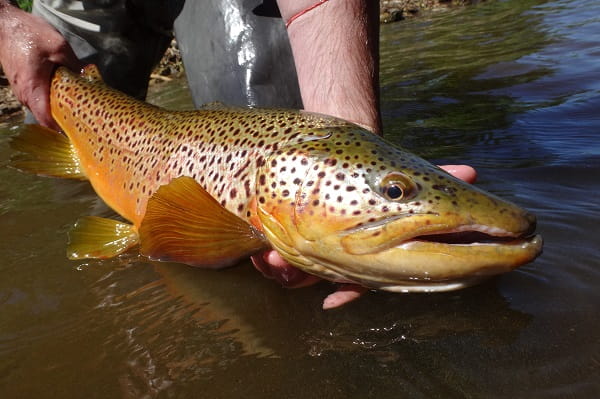
This is a good tip for any fisherman who wants to catch trout in a stream. Avoid fake baits and use the most natural baits possible.
Avoid bad baits like trout dough, plastics, corn, and marshmallows.
And when fishing trout in small streams, go with small baits first, even for big trout. Trout tend to eat almost anything that drifts by them, and this includes big trout.
In smaller streams even small spawn bags or a single salmon eggs work well, smaller lures will work well too.
20. Walk Before You Start Fishing
Most anglers start to fish at the closest pool to their vehicle, and then they hit the next one, and then the next one.
These spots get fished really hard ,and some fish might even get caught and taken home for the frying pan, so there is fewer fish in the pools close to the parking area.
Spots that get heavily fished will also have nervous wary fish that are harder to catch.
That’s why it’s often better to walk for 5 to 10 minutes up or down the river before you start fishing. Spots that are a 10-minute walk from the parking spot are far less likely to get fished as much.
I will often walk 30 or 40 minutes up or down the river first and then fish my way back to the car.
21 Check The Water Temperature
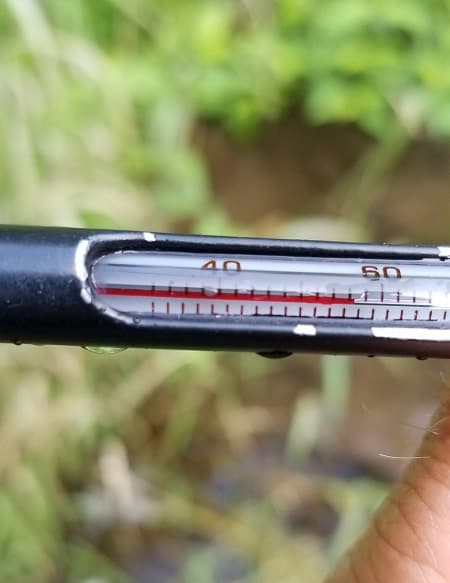
I use a small and inexpensive stream thermometer to check the water temperature, especially in late summer. The reason is trout will stop feeding if the water temperature exceeds 67F or 18C
When it gets too warm, I go fish in colder streams or move way upriver to the colder headwaters.
22. Most Important Tip On How To Catch Trout In A Stream
This is probably the most important tip I can give any angler who wants to catch more trout.
It’s very important that everything you do works well together. An example of this would be to use the perfect bait on the right size hook, using my leader setup and the right leader size, and then present it perfectly.
Getting one little thing wrong, such as a hook that is too big or the leader line that is too thick, can prevent fish from biting. Even if everything else is perfect.
One wrong thing can make all the right things useless.
If you have a question, comment, or even a tip about how to catch trout in a stream, let me and all the readers know in the comment section below.
Tight Lines,
Graham
References:
Trout Tracking Studies: Why Do Trout Migrate?
Effects of feeding level and water temperature on growth – https://www.sciencedirect.com/science/article/abs/pii/S0990744098890050
